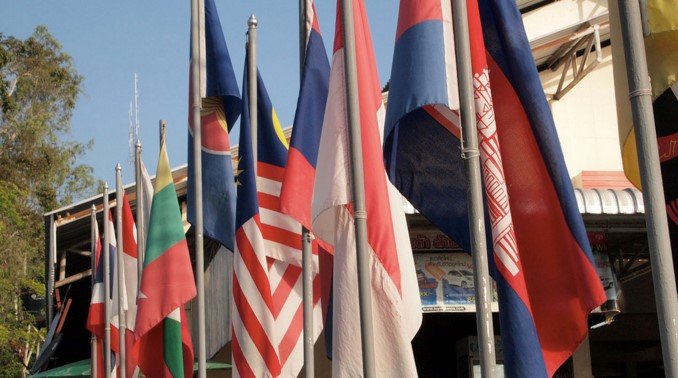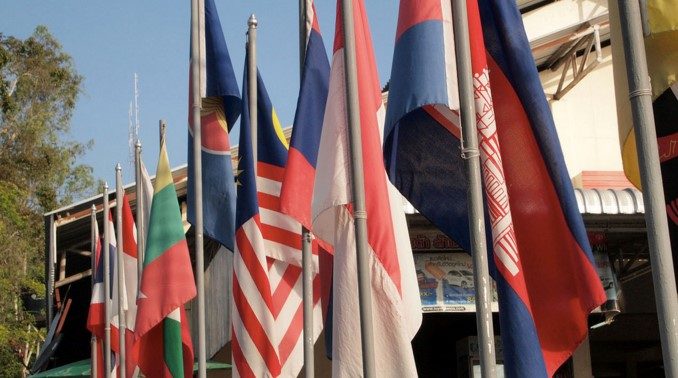
Photo: Prachatai via flickr
At a time when the region faces a multitude of challenges, some are questioning whether the chair is up to the job.
2016 is a big year for ASEAN. It began with the quiet launch of the ASEAN Economic Community (AEC), which was followed by the Sunnylands Summit; the first time all ASEAN leaders met a US President on US soil. Now the region is facing intense scrutiny over its approach to the South China Sea dispute, as well as severe droughts threatening the Mekong region.
However, there are many who doubt whether this year’s chair of ASEAN is up to the job. The role of ASEAN chair rotates annually, and this year it has fallen to the Lao People’s Democratic Republic: a one-party, authoritarian state with no political opposition, dismal media freedom and rampant corruption.
ASEAN is a quiet organisation that takes pride in not making too many waves. It makes decisions by consensus, and all members have the equal capacity to block a policy proposal, with the chair mainly serving as a coordinator and host-nation for summits. For a long time, the identity of the chair was never cause for much international interest. That changed in 2012, when Cambodia took its turn.
2012 has gone down in ASEAN history as its least functional. It was the first time that the group failed to agree on language to include in their final joint statement concerning the South China Sea, a fact which has been widely attributed to Chinese pressure on Cambodia to stymie such language. At the time China was one of Cambodia’s biggest aid donors.
After Cambodia’s disastrous chairmanship, Brunei, Myanmar then Malaysia have taken the reins, without major incident. However, the South China Sea issue has been dominating regional debates this year, and the issue is currently before the Permanent Court of Arbitration (PCA) at The Hague.
A ruling on the Philippines’ argument disputing the validity of China’s nine dash line claims is expected by June 2016, but China has refused to participate in proceedings and has made it clear it will not recognise any ruling made by the court.
In February ASEAN announced the group was “seriously concerned” over China’s actions in the South China Sea, however the real test will come after the ruling is issued. Should the PCA find in favour of the Philippines’ claim, as many are predicting it will, the question will be whether ASEAN will support the Philippines in any attempt to enforce the ruling against China.
Laos’ significant economic reliance on China will likely put it in the same position as Cambodia was four years ago. With Brunei, Malaysia, Vietnam and the Philippines each claiming part of the sea, if Laos does bow to Chinese pressure on the nine dash line, ASEAN will face potentially destructive internal division.
Another issue that ASEAN would do well to tackle this year is the severe drought that has hit the Mekong region, where temperatures are soaring and the monsoon season has been delayed. On this issue, Laos may have to tread carefully, as their Don Sahong and Xayaburi dams are two of the most controversial of the 70 new dams expected to be operational along the Mekong by 2030.
Experts have suggested that the dams could jeopardise the livelihoods of the estimated 60 million people. Laos’ vested interest in hydropower brings its ability to deal with the drought impartially into question.
2016 is also a critical year for ASEAN as it has launched the AEC, a community 10 years in the making, whose future currently rests on Laos’ shoulders. The AEC is very ambitious for ASEAN, usually a cautious institution. However, the announcement of the launch of the AEC was only a first step, and it is still very much a work in progress.
Questions have been raised over whether Laos is equipped to deal with the range of issues it faces as chair this year. Already international media groups are asking whether they will be given sufficient access to cover the many ASEAN meetings which will be held in Vientiane. Laos is known for being a harsh climate in which to be a foreign journalist, announcing in January 2016 that the Foreign Ministry has to vet all articles produced by foreign media and journalists need to apply for visas 15 days in advance (when non-journalists can get a visa on arrival).
The Laos government denied it restricts foreign media, offering the illuminating statement: “We don’t have restrictions but procedures,” clarifying that the above rules only apply to film-makers, but that journalists covering the summits would need to be escorted by officers and have their questions and subjects vetted by the Foreign Ministry.
Some have labelled 2016 as Laos’ “coming of age”, and others have warned of the threat the country’s chairmanship poses to the region as a whole. Either way, it is certain that a great many challenges face Laos as it chairs ASEAN this year. There is certainly no guarantee that it is in a position to effectively manage the competing priorities of 10 member states.
Caitlin McCaffrie lives and works in Phnom Penh and has a major interest in Southeast Asian politics.
 Facebook
Facebook  Twitter
Twitter  Soundcloud
Soundcloud  Youtube
Youtube  Rss
Rss 